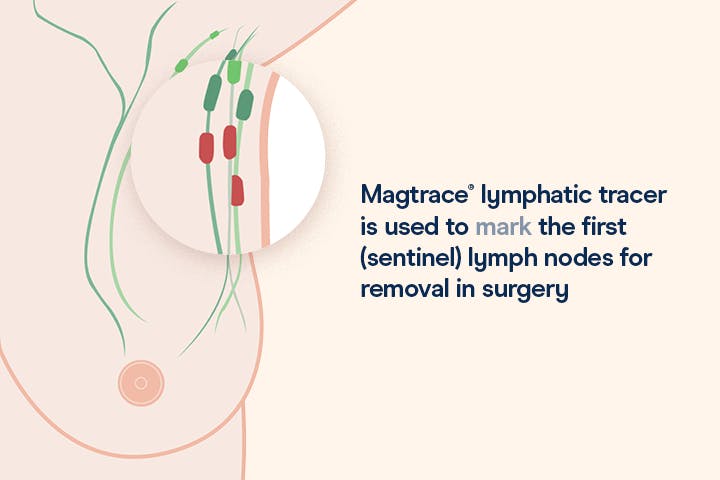Sentinel lymph node biopsy with Magtrace® lymphatic tracer

Why have I been recommended for a sentinel lymph node biopsy?
When you have surgery to remove a suspicious lump, it is important for your surgeon to know whether the cancer cells have spread to other parts of the body. This allows them to determine the ‘stage’ of the disease.
The simplest way to establish this is by analyzing your body’s lymph nodes. If cancer cells break away from their original site, they will travel throughout the lymphatic channels that run to your underarm. Here they will collect in the first lymph nodes they reach – known as the ‘sentinel lymph nodes’.
What exactly is involved in a SLNB procedure?
A sentinel lymph node biopsy (SLNB), is a cancer staging procedure which is carried out at the same time as the removal of a suspicious lump from your breast.
It involves identifying and then surgically removing a small selection of sentinel lymph nodes, before analyzing them to determine whether the cancer has spread.
How surgeons use Magtrace®
To help identify the sentinel nodes, the Magtrace® lymphatic tracer will be injected into your breast. This magnetically detectable ‘tracer’ liquid will follow the route that a migrating cancer cell would take, before collecting in the sentinel nodes in your underarm.
Once the tracer has migrated to your sentinel nodes, your surgeon will then be able to identify the location of these nodes by using a magnetic probe which can detect even minute quantities of the tracer liquid.

The unique properties of Magtrace ensures your surgeon removes only the nodes that could contain cancer cells, leaving your healthy nodes untouched.
The procedure - what can I expect?

 Magtrace® lymphatic tracer marking lymph node illustration
Magtrace® lymphatic tracer marking lymph node illustrationInjection before surgery
The Magtrace® lymphatic tracer will be injected at a time that suits you and your surgeon.
It can be administered at the start of your surgery when you’re under anesthesia, or many days or weeks beforehand, timed to coincide with your pre-surgical visit to the hospital or at a time that is convenient to you.
If administered beforehand, local anaesthetic or a numbing gel will be applied. Your surgeon will then use a small needle to inject the liquid into your breast.
After the injection
Shortly after the injection, the Magtrace® lymphatic tracer liquid will flow through your lymphatic system, taking the route a migrating cancer cell would take, before collecting in the sentinel nodes in your underarm.
Only the sentinel lymph nodes will be marked by Magtrace®.
In a small number of patients injected with Magtrace®, discoloration of the skin at the injection site can occur.
This is a tiny amount of the tracer which has remained under the skin. Any discoloration will fade over time.
Surgery
During the procedure, your surgeon will use a Sentimag® probe to locate the Magtrace® lymphatic tracer in your sentinel lymph nodes. Once found your surgeon will usually remove two or three nodes to analyze.
A pathologist will examine the specimens to confirm if any cancer cells are present in the lymph nodes and help determine if the cancer has begun to spread.
This process can take some time, so if you do not hear back straight after surgery, do not worry.
What will the results from the analysis tell me?
The analysis will determine if cancer cells are present in your lymph nodes and how much is in each one.
This will help to accurately stage your cancer and help determine your best course of treatment, which may include additional therapy, such as chemotherapy and radiation.
Where can I find out more?
If you have any more questions about your surgery, please do ask your surgeon or the hospital team.
Thousands of surgeons and radiologists from across the world now use the Magtrace® lymphatic tracer. You can hear our interviews with a selection of these surgeons on the videos page.